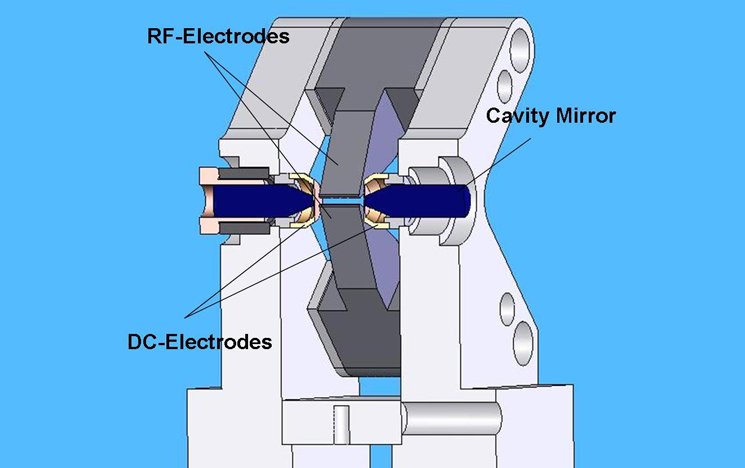Probabilistic ion-photon interaction
The goal of this experiment is to generate entanglement between multiple ions in the same trap by coupling them to the same mode of an optical cavity. In addition to studying quantum effects such as entanglement and decoherence, such a system can be used as a node in a quantum network or as an interface for a quantum computer. Furthermore, this source of entangled ions could be used in the development of an alternative type of quantum information processor known as a cluster-state quantum computer.
When an ion in a cavity emits a photon, the frequency of which is resonant with the cavity, the photon may be picked up by the cavity and emitted through one of the mirrors. By driving atomic transitions in the ions using a sequence of laser pulses, and measuring the fluorescence of the ions via the emission from the cavity, the ions can be projected into an entangled state. This entanglement is generated with some probability each time the sequence is repeated, hence ‘probabilistic entanglement’.
In addition to entanglement generation, the ion trap may be used as a source of pure single photons. By preparing a single ion in a specific state, and then driving an atomic transition once with a laser pulse, a single photon is produce in the cavity through what is known as cavity-assisted Raman transition. A photon produced in this way may be encoded with quantum information or entangled with the ion, vital steps in creating a quantum internet.
As ions are charged, they may be confined by creating a region of minimum electric field by applying voltages to electrodes in carefully designed configurations. The ion trap used in this experiment is a linear Paul trap, where blade-shaped radio-frequency (rf) electrodes form an axis of electric field minimum along which a long string of calcium-40 ions can be confined, with dc electrodes at either end of the axis.

Integration of a cavitiy into an ion trap
The optical cavity is formed of mirrors embedded within each of the DC electrodes, such that the cavity axis lies along the trap axis. The dc electrodes provide a high degree of control over the spacing of the ions, so that several ions can be optimally coupled to the cavity simultaneously.